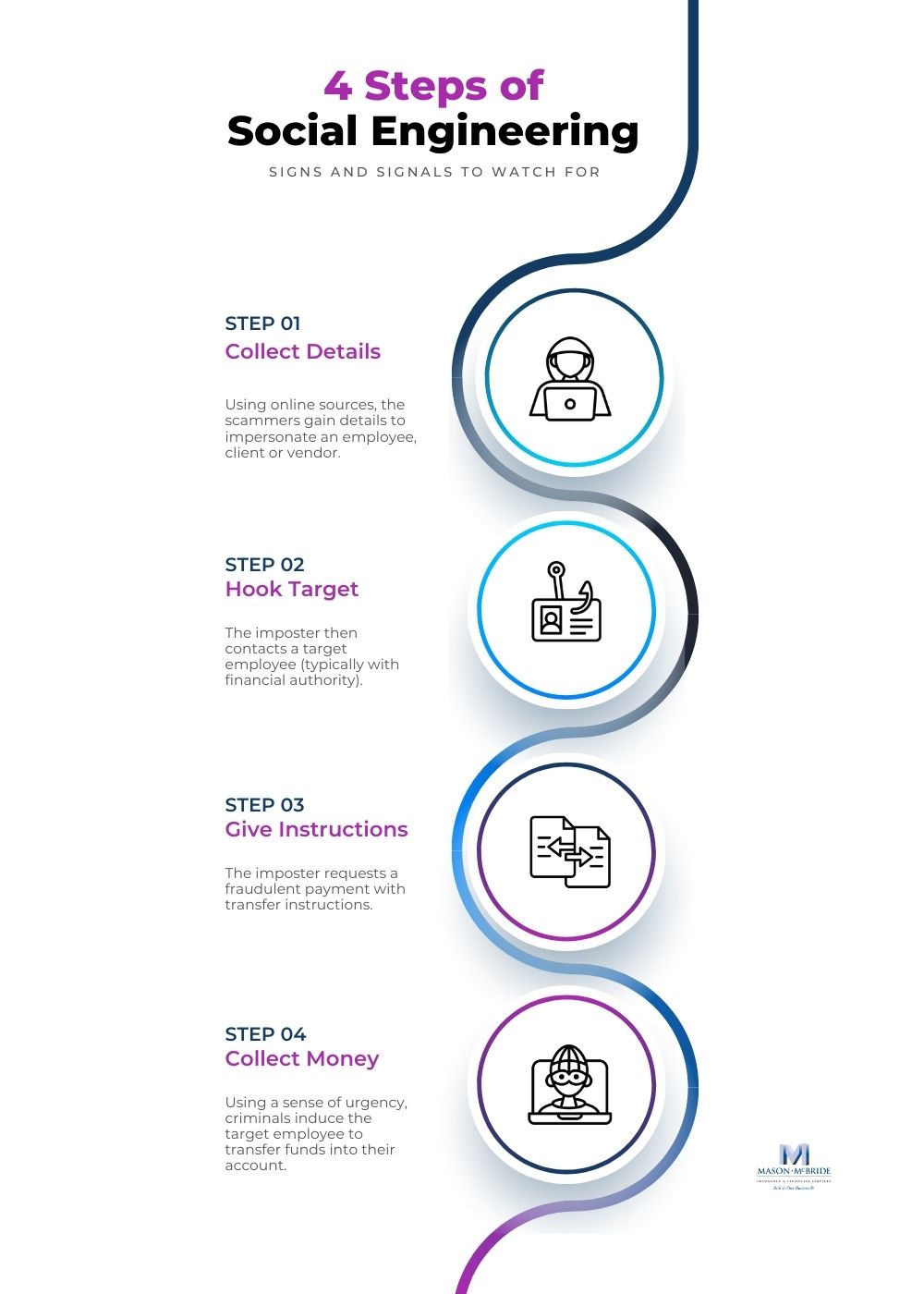Cybercriminals create new advanced social engineering tactics and target small and medium-sized businesses. For example, the FBI estimates that cybercriminals stole more than $28 billion through email fraud from 2016-2020, with an average loss per incident of more than $150,000.
Social engineering fraud involves tricking employees into divulging sensitive information or assisting in a fraudulent scheme. Business owners and IT professionals must be vigilant in identifying and preventing these attacks in order to reduce exposure.
As these social engineering tactics continue to evolve, business owners and IT professionals must adapt their approach to cybersecurity to mitigate the risks. Identifying and preventing these attacks is essential to protect your business and your clients’ sensitive information. Cyber insurance can provide an additional safeguard against these risks by providing coverage for losses resulting from cyber-attacks.
Understanding Social Engineering Attacks
While phishing and other online crimes have been problems for businesses for many years, social engineering fraud is increasingly leveraging information from corporate sources, including social accounts, to target companies, vendors, and executives.
Social engineering can be described as the art of human hacking by impersonating executives, employees, vendors, and suppliers.
Social engineering, in its basic form, is tricking an individual into providing commercial or personal information, usually done through technology.
However, unlike technical hacking, which is designed to gain access to systems or data, social engineering scams exploit a human weakness, curiosity, and anxiety through deception to manipulate them to use the information gathered for fraudulent purposes.
The most common social engineering attack is the unintended payment or transfer of funds made to cyber scammers through this deception.
Real-Life Social Engineering Claim Scenario
Consider this claim example of a social engineering scam on a business:
The company accountant receives an email from the CEO that looks legitimate but is fake and includes a link to a login page where the hacker harvests company credentials. The cybercriminal then uses the credentials to log in and transfer funds from the company bank account to an illegitimate bank account.
In this scenario, because the cybercriminal gets credentials and gains unauthorized and persistent access to company assets until discovered and stopped, financial loss and expenses could trigger the Computer and Funds Transfer Fraud coverage (FTF) if all other conditions for FTF are met.
Claim Scenario provided by Cowbell
Advanced Social Engineering Schemes
- Baiting – attackers lure users into a trap that steals their personal information.
- Scareware – users are deceived into thinking their system is infected with malware.
- Pretexting – attackers obtain user information through a series of cleverly crafted lies.
- Phishing – attackers forward an email or text to the target seeking information that might help with a more significant crime.
- Spear Phishing – attackers tailor their message based on job positions in contacts belonging to the victim to make their attack less conspicuous.
- Tailgating – attackers closely following an authorized person into a restricted access area to commit a crime.

Protect Your Business From Advanced Attacks
Post-COVID-19, more and more businesses are working remotely and moving more information to the cloud. As a result, phishing is at an all-time high and is still the most successful social engineering threat.
Phishing continues to increase at alarming rates. The scammers use new apps that can easily evade network security. The most common companies impersonated by phishers are Microsoft, Google, Facebook, Apple, and Paypal.
According to the FBI’s Internet Crime Complaint Center, BEC attacks (Business Email Compromise attacks) have increased by over 2,370% since 2015. The scammer’s email will look authentic and appear from a known authority figure, compelling the employee to open the email and act upon the request.
Since BEC attacks don’t involve malware based on social engineering tactics, they also can evade antivirus and spam filters. As a result, the expectation is that companies will invest more in their front lines of defense, such as education, training, and implementing multi-factor authentication. Moreover, most insurance companies will no longer provide cyber coverage to a company without multi-factor authentication.
Deepfake and Nation-State Attackers
Deepfake technology and nation-state attackers use social engineering tactics to manipulate information, destroy credibility, and impersonate trusted sources. The potential impact of deepfakes is still being measured, but the technology is so powerful that it can be used to create bogus messages that can scam businesses.
In addition, nation-state attackers can leverage deepfakes to create fake viral videos of politicians, spread disinformation, manipulate sentiments, spark outrage and hatred, and even topple governments.

Shield Your Business with Cyber Insurance Coverage
Businesses can face significant financial losses and disruption as a result of cyber incidents. While implementing cyber security best practices can help manage privacy risks; it’s also important to consider cyber liability insurance as part of a comprehensive risk management strategy.
With cyber liability insurance, businesses can access a team of professionals who can respond quickly in the event of an attack. This can include forensic experts, attorneys, breach response specialists, and credit monitoring companies.
Cyber liability coverage is a cost-effective way to protect a company’s balance sheet from losses that are not typically covered under traditional insurance policies. In addition to covering first-party costs such as forensic investigations and notification, cyber coverage can also extend to third-party claims alleging unauthorized disclosure of personal or confidential data.
Take Action to Safeguard Your Data
Find out how Mason-McBride can protect your company and request a proposal.
For helpful tips on other popular topics, check out articles on:
- Cyber Insurance Exclusions
- Decoding E&O Insurance Policy Language
- Ransomware Developments
- Cybercrime Targeting Small Businesses
Article By Jamie Parry
